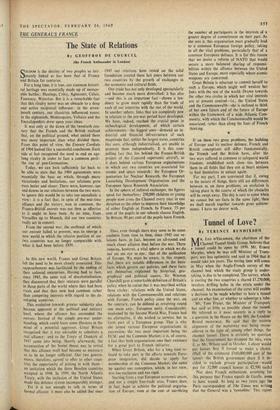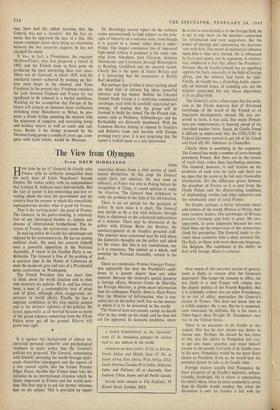Tunnel of Love?
By TERENCE BENDIXSON
MR. LEO D'ERLANGER, the chairman of the Channel Tunnel Study Group, believes that a tunnel could be open by 1970. Mr. Ernest Marples, when he was still Minister of Trans- port, was less optimistic and said in 1964 that it would take ten years. The testing time will come in May when the Anglo-French survey of the channel bed, which the study group is under- taking, is due to be completed. The survey, which is costing the-two countries a shared £1,250,000, involves drilling holes in the strata under the channel. An examination of the cores will enable a decision to be made whether to bore a tunnel and on what line, or whether to submerge a tube.
Mr. Tom Fraser, the Minister of Transport, has said as little as possible about the• tunnel. He referred to it most recently in a reply to a question in the House on the M4, the London- Bristol motorway. He said that the eastern alignment of the motorway was being recon- sidered in the light of, among other things, the channel tunnel. There is certainly no question that the Government has dropped the idea, even if, as Mr. Wilson said in October, Labour would put houses first if forced to make a choice. (Half of the estimated £160,000,000 cost of the tunnel—the British government share if it de- cided to exclude private participation—would pay for 32,000 council houses at £2,500 each.)
Nor does French enthusiasm, assuming for this purpose that France equals de Gaulle, seem to have waned. As long as two years ago the Paris correspondent of The Times was writing that the General was a 'ttinneliste.' This report
may have had the added meaning that the General was not a 'pontiste,' but the fact re- mains that he approved the idea of a link. His recent comment about there being no mountains between the two countries suggests he has not changed his mind.
It was, in fact, a Frenchman, the engineer Mathieu-Favier, who first proposed a tunnel in 1802, and the French seem to have gone on producing the most interesting ideas ever since.. There was de Gamond, in about 1850, with his ventilated tunnel—achieved by pushing up thir- teen mole heaps in the channel, and Yona Friedman in the present day. Friedman considers the joint between England and France far too significant to be reduced to a buried umbilicus. Working on the assumption that Europe of the future will contain an immense linear civilisation stretching from Manchester to Milan, he pro- poses a titanic bridge spanning the channel with the minimum of supports, and sustaining towns and holiday resorts as well as roads and rail- ways. Beside it the bridge proposed by the Dorman Long group a couple of years ago, com- plete with cycle tracks, would be Meccano. Dr. Beeching's second report on the railways seems unconsciously to lend support to the prin- ciple of linearity on a national scale, even though it is geared to a tunnel rather than a super- bridge. The longest continuous line of improved high-speed railway it proposes is the route run- ning from Aberdeen, past Glasgow, between Manchester and Liverpool, through Birmingham to Reading, Guildford and the channel tunnel. Clearly this is the spine of future Britain and it is interesting that the economists at British Rail identified it.
But perhaps that is what is most exciting about the fixed link—it attracts big ideas, powerful interests and big money. Behind the Channel Tunnel Study Group is a ramifying commercial cousinage, each with its carefully negotiated per- centage, all hoping that the group will be licensed to build the tunnel. On the French side, names such as Pechiney, Schlumberger and the Rothschilds are discreetly mentioned. With the Common Market itching to expand its frontiers and Britain's trade and tourism with Europe growing every year, it is not surprising that the tunnel is looked upon as a safe investment.



































 Previous page
Previous page